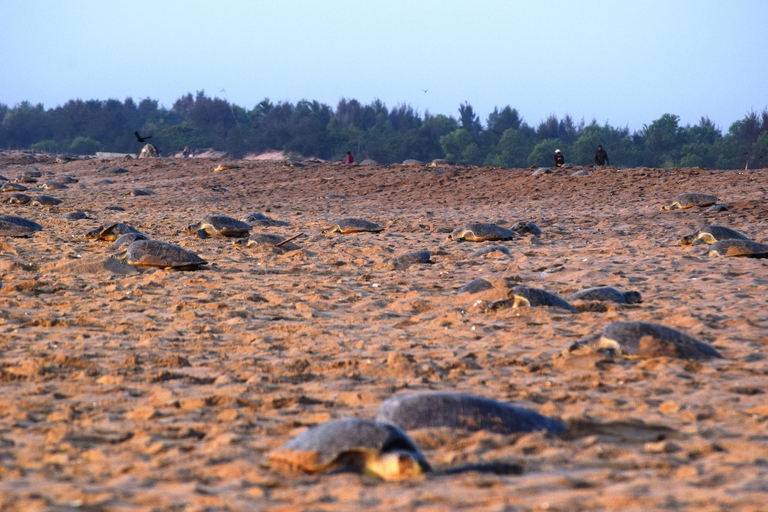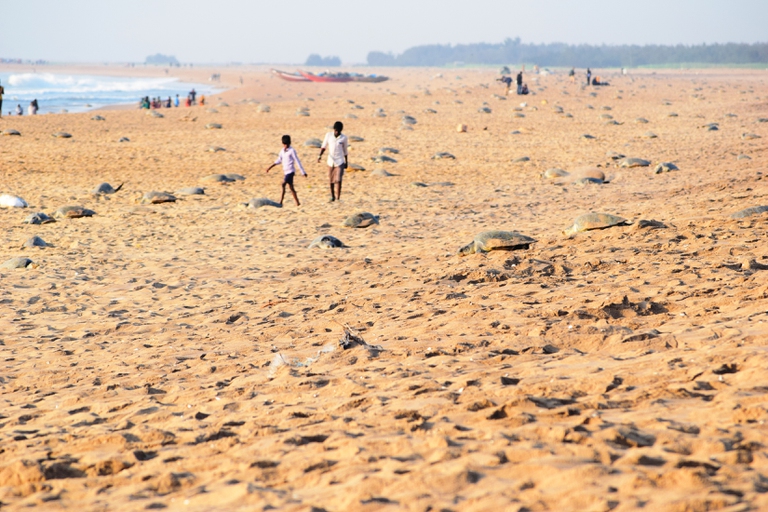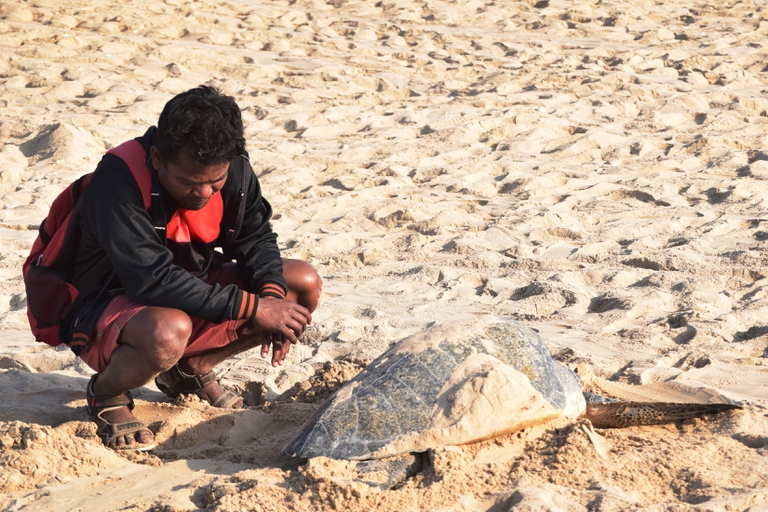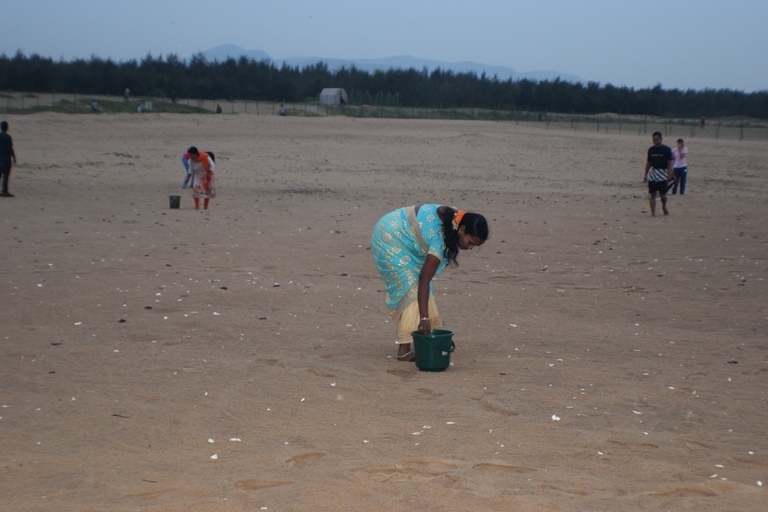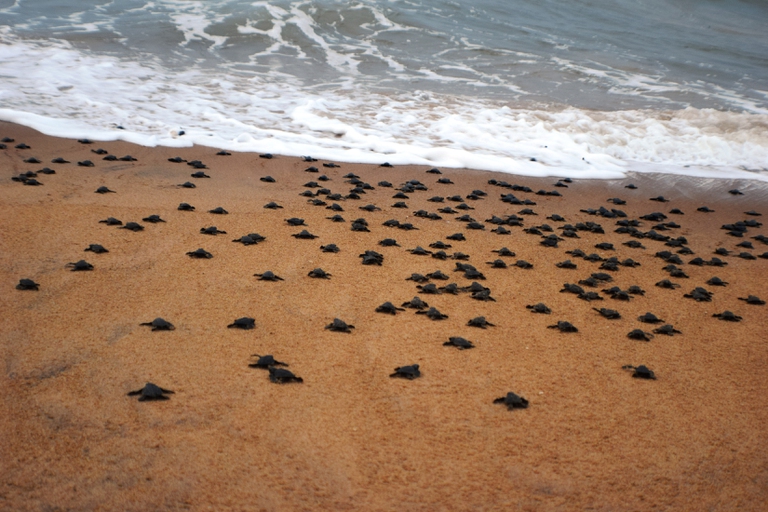
A group of experts in Tokyo suggested pouring radioactive water from Fukushima into the open sea. A marine biochemist explains the consequences of this absurd decision.
Fishing communities in eastern India are setting an example by protecting endangered olive ridley marine turtles during their annual mating and nesting activities, and helping millions of tiny hatchlings reach the sea safely.
As the nesting season begins, the beach between Podampeta village in Ganjam district of Odisha, India, and the Bay of Bengal gets thickly dotted with thousands of olive ridley marine turtles. Female sea turtles visit the beach en masse for the annual nesting activity called arribada, which is a synchronised, large-scale nesting of sea turtles on any single beach.
Nearby beaches at Gokharkuda and Purunabandh villages also receive similar number of turtles that cover thousands of kilometres in the sea from the Indian Ocean to the coasts of the Bay of Bengal in Odisha, for mating and nesting activities. In 2018, beaches at the Rushikulya river mouth received nearly 500,000 mother turtles. This year, though, the activity is delayed at these places, maybe, because of changes in climatic and beach conditions.
The eastern Indian province of Odisha has three known mass nesting destinations. While the Gahirmatha and Rushikulya river mouths attract hundreds of thousands of turtles every year, regular sporadic events are spotted at the Devi river mouth. According to official estimations, Odisha witnessed the mass nesting of over 1.2 million female sea turtles in 2018.
As turtle nesting starts after midnight and continues until morning, threats to the turtles and their eggs from scavenging animals like dogs and birds including crows and kites are always around the corner. But activities can go on undisturbed thanks to local fishing communities who protect the eggs and help mothers return to the sea.
“Trapped in the nets used by fishing trawlers, many of these mothers come with injuries in their legs and neck. We need to take care of such mothers,” Magata, a volunteer from the fishing community says while helping an injured turtle.
As millions of hatchlings emerge from the sands after about 45 days of nesting, women, children and men of the communities come together to ensure that the hatchlings reach the sea before the sun goes high and the sand becomes too hot.
“In the past these communities were predating on the marine turtles and their eggs,” tells B. Chittamma, the leader of coastal fisherwomen. “Now, they regulate the use of fishing nets and respect government’s ban on fishing within five kilometres from the coast for seven months, from November till May.”
“We feel proud of these turtles. They have made our beaches important,” says Sunita, a villager of Puruna Bandha near Rushikulya river mouth.
This has been possible through a series of awareness programmes, according to Rabindranath Sahu of Rushikulya Sea Turtle Protection Committee. “Regular visit by olive ridley turtles is a sign that our coastal ecosystem is healthy with sufficient fishes and planktons around to create food opportunities for the marine turtles,” says Mangaraj Panda of Odisha Marine Resource Conservation Consortium.
The olive ridley sea turtle (Lepidochelys olivacea), also known as the Pacific ridley sea turtle, is the smallest of all marine turtle species. Mostly found in warm and tropical waters of the Pacific and Indian Oceans as well as in the warm waters of Atlantic Ocean, the species is named after its olive coloured, heart-shaped carapace. The species has been categorised as vulnerable by the IUCN red list of threatened species.
The beaches of Odisha are special because of the relatively large size of sand grains where female turtles can easily dig a hole to lay over 100 eggs of golf ball size. Sufficient food opportunities for hundred thousands of turtles while mating and millions of hatchlings are the other attractions.
While making their way from the nest to the water, the hatchlings imprint a type of magnetic signature of the nesting beach into their minds, which stays with them for the rest of their lives. They visit the same beach after attaining sexual maturity at the age of 15. However, of the millions venture into the sea, only a few thousand turtles survive to become adults and come back for nesting.
Usually, the turtles reach Odisha coasts during October for mating. They nest on the beach in the months of February and March and the season continues till the end of May or even beyond until all the tiny hatchlings make their way into the open sea.
Siamo anche su WhatsApp. Segui il canale ufficiale LifeGate per restare aggiornata, aggiornato sulle ultime notizie e sulle nostre attività.
![]()
Quest'opera è distribuita con Licenza Creative Commons Attribuzione - Non commerciale - Non opere derivate 4.0 Internazionale.
A group of experts in Tokyo suggested pouring radioactive water from Fukushima into the open sea. A marine biochemist explains the consequences of this absurd decision.
The decline in grey and humpback whales in the Pacific and Atlantic Oceans has been traced to food shortages caused by rising ocean temperatures.
The United Nations has launched a major international alliance for ocean science, undertaking a mission close to all our hearts.
The cargo ship that ran aground off the coast of Mauritius on 25 July, causing incalculable damage, has split in two and its captain has been arrested.
The largest coral reef in the world is severely threatened by climate change, but researchers are developing strategies that could contribute to saving the Great Barrier Reef.
Seychelles have extended its marine protected area, which now covers over 400,000 square kilometres, an area larger than Germany.
Norwegian oil giant Equinor had pulled out of drilling for oil in the Great Australian Bight, one of the country’s most uncontaminated areas. A victory for activists and surfers who are now campaigning for the area to be protected forever.
30 per cent of the planet needs to be protected to stop precipitous species decline. The UN has set out its aims for the the COP15 on biodiversity scheduled for Kunming, China in October.
Ocean warming has risen to record highs over the last five years: just in 2019 the heat released into the world’s oceans was equivalent to that of 5-6 atomic bombs per second. The culprit, no doubt, is climate change.
